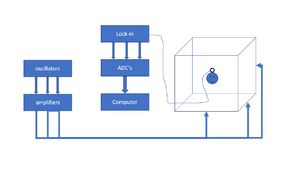EM Field Head Tracking System specifications

Introduction
The EM Field Head Tracking System is used for recording head movements of the subject during a trial. The system consists of the following parts:
- Three oscillators at roughly 45, 55 and 65 kHz or 50, 60, 70 kHz for X, Y and Z direction.
- Three signal amplifiers that amplify the oscillator signals.
- six field coils that make a cube of roughly 3x3x3 meters.
- A small pick-up coil mounted on a glasses frame that is worn by the subject during the experiment.
- Three lock-in amplifiers that split the signal from the pick-up coil in the 3 frequency components and measures their envelope. They output analog signals between -10V and +10V.
- An acquisition device converts the analog output signals from the lock-in amplifiers to digital.
- A RZ6 multi I/O processor that records the acquired data.
- Software that converts the recorded data to head orientations using calibration data.
The following table contains the channel convention with respect of the three directions:
| Channel | Frequency | Orientation | Color | Polarity |
|---|---|---|---|---|
| Channel 1 | 45/50 kHz | Frontal | Red | Front = positive; Back = negative |
| Channel 2 | 55/60 kHz | Vertical | Blue | Right = positive; Left = negative |
| Channel 3 | 65/70 kHz | Horizontal | Yellow | Up = positive; Down = negative |
Parts
Lock-in amplifiers
Three Femto LIA-BV-150-H Lock-in amplifiers are used in order to separate the Frontal, Horizontal and Vertical signals from the signal that is coming from the pick-up coil. Each Lock-in amplifier has a Sinus Oscillator Module (SOM-1) that is used both as Field Modulation Signal and as Reference Signal. The Lock-in amplifier settings are set at the front of the device (see picture), except for the modulation/reference frequency which is set inside on the SOM-board.
| Kenmerk | LIA-BV-150-H |
|---|---|
| Model | Single Phase |
| Werkfrequentie | 50 Hz - 120 kHz |
| Tijdconstanten | 300 µs - 1 s (6 of 12 dB/oct.) |
| Verstelbaar Signaalfilter | Highpass 2 Hz - 10 kHz, Lowpass 100 Hz - 1 MHz |
| Datasheet | 367 kB |
| Uitgangen | X = in fase, Y = kwadratuur, R = magnitude, ±10 V volledige schaal, kortsluitbeveiligd, Signaalmonitoruitgang |
| Gevoeligheid (Volledige Schaal) | Voltage: 3 µV - 1 V in 1-3-10 stappen |
| Spanningsingang | Echte differentiële instrumentatieversterker, ruis 12 nV/√Hz |
| Stroomingang | Transimpedantieversterker, versterking 100 kV/A, ruis 0.4 pA/√Hz |
| Referentie-ingang | ±100 mV tot ±5 V, schakelbaar naar TTL |
| Fase | Aanpasbaar 0° - 360°; resolutie: 8-bit @ f ≤ 60 kHz, 7-bit @ f > 60 kHz, Temperatuur drift <0.01°/K |
| Max. Dyn. Reserve | 80 dB |
| Digitale Controle | 16 TTL/CMOS ingangen: 8-bit fase, 4-bit tijdconstante, 4-bit gevoeligheid |
| Voeding | ±15 V, +120 mA / -60 mA |
| Afmetingen | 160 x 100 x 20 mm (L x B x H), gewicht 100 g (0.22 lbs) |
The front panel of each LIA has four dip-switches:
- Mode: 1f means that the fundamental harmonic is measured (2f = second harmonic signal)
- Dyn.Res.: For dynamic reserve the settings Low (L) is preferred because the signal is normally large in comparison with the noise.
- PLL: For the Phase Lock Loop (PLL) the settings Slow (S) is preferred because the frequency is at a fix value. The phase is more stable in this setting.
- Ref.Thr.: Reference Threshold is set to 0V for analog signals (2V is for digital signals).
Oscillators
Amplifiers
%todo
Resonance circuits
%todo
Wall coils
%todo
Pick-up coil
%todo
Lock-in amplifiers
%todo
ADC's
%todo
recording device
(RZ6 or RA16) %todo